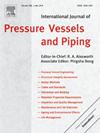Gr.91钢瞬态蠕变速率的控制因素及相关参数
IF 3
2区 工程技术
Q2 ENGINEERING, MECHANICAL
International Journal of Pressure Vessels and Piping
Pub Date : 2025-04-28
DOI:10.1016/j.ijpvp.2025.105538
引用次数: 0
摘要
研究了Gr.91钢在550、600和650℃温度下瞬时区蠕变速率的控制因素及相关参数(至最小蠕变速率的时间tm、应变至最小蠕变速率的εm和最小蠕变速率的ε˙min)。在瞬态区早期0.2 h时,蠕变速率随抗应力增加0.2%而降低。随着应力的减小,tm的增加在低应力下变得不那么显著,类似于破裂时间。在高于临界应力的高应力下,εm约为2.2%,而在低于临界应力时,由于蠕变局部化(可能在奥氏体晶界附近),εm随应力的减小而减小。强热表现为tm大,εm小。在临界应力以上的高应力水平下,ε˙min与tm成反比,ε˙min = 1.2 × 10−2/tm。当应力低于临界应力时,tm和εm均随应力变化,ε˙min为ε˙min = 0.54 (εm/tm)。本文章由计算机程序翻译,如有差异,请以英文原文为准。
Controlling factors for creep rates and relating parameters of Gr.91 steel in transient region
The controlling factors for the creep rates in the transient region and for the relating parameters, such as the time to minimum creep rate tm, strain to minimum creep rate εm and minimum creep rate min, have been investigated for Gr.91 steel at 550, 600 and 650 °C. The creep rates at 0.2 h, an early stage of transient region, decrease with increasing 0.2 % proof stress. The increase in tm with decreasing stress becomes less significant at low stresses, similar as the time to rupture. The εm is approximately a constant of 2.2 % at high stresses above a critical stress, while it decreases with decreasing stress below the critical stress by the localization of creep deformation, presumably near prior austenite grain boundaries. The strong heats exhibit large tm but small εm. At high stress level above the critical stress, the min is inversely proportional to the tm as min = 1.2 x 10−2/tm. At stresses below the critical stress, both the tm and εm change with stress and the min is given by min = 0.54 (εm/tm).
求助全文
通过发布文献求助,成功后即可免费获取论文全文。
去求助
来源期刊
CiteScore
5.30
自引率
13.30%
发文量
208
审稿时长
17 months
期刊介绍:
Pressure vessel engineering technology is of importance in many branches of industry. This journal publishes the latest research results and related information on all its associated aspects, with particular emphasis on the structural integrity assessment, maintenance and life extension of pressurised process engineering plants.
The anticipated coverage of the International Journal of Pressure Vessels and Piping ranges from simple mass-produced pressure vessels to large custom-built vessels and tanks. Pressure vessels technology is a developing field, and contributions on the following topics will therefore be welcome:
• Pressure vessel engineering
• Structural integrity assessment
• Design methods
• Codes and standards
• Fabrication and welding
• Materials properties requirements
• Inspection and quality management
• Maintenance and life extension
• Ageing and environmental effects
• Life management
Of particular importance are papers covering aspects of significant practical application which could lead to major improvements in economy, reliability and useful life. While most accepted papers represent the results of original applied research, critical reviews of topical interest by world-leading experts will also appear from time to time.
International Journal of Pressure Vessels and Piping is indispensable reading for engineering professionals involved in the energy, petrochemicals, process plant, transport, aerospace and related industries; for manufacturers of pressure vessels and ancillary equipment; and for academics pursuing research in these areas.

 求助内容:
求助内容: 应助结果提醒方式:
应助结果提醒方式:


